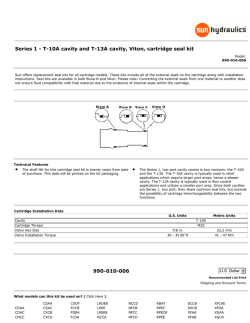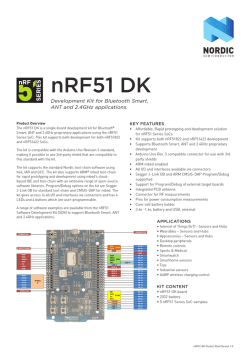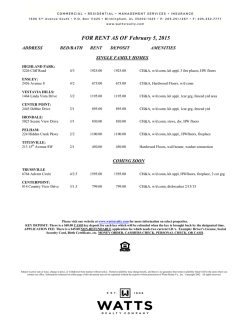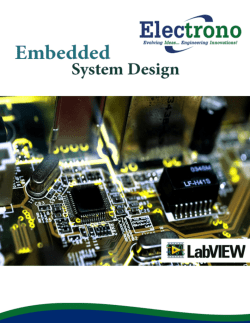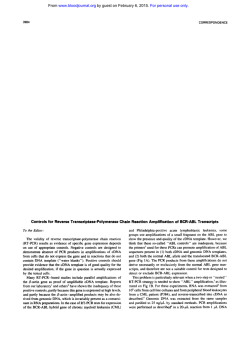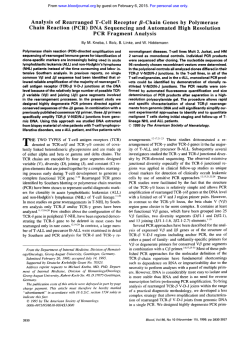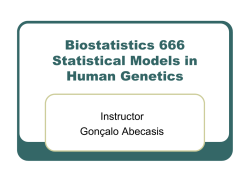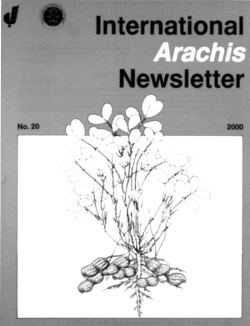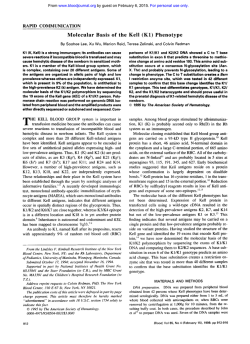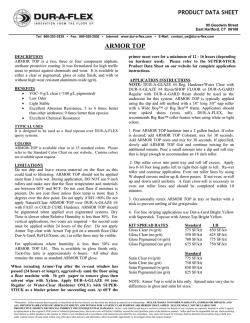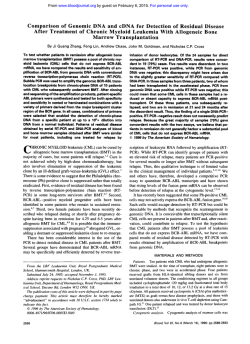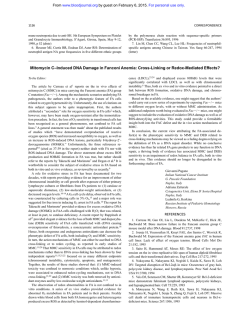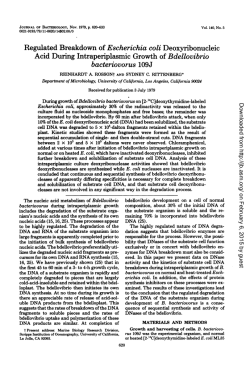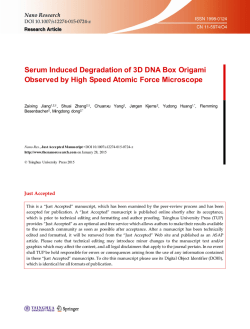
A09-004A Prime Pro 48 Food Allergens
Application Note A09-004A Detection of food allergens by real-time PCR Introduction For people with food allergies, consuming products contaminated with allergenic ingredients can lead to serious consequences, therefore correct food labelling is extremely important to enable informed choices. Currently there are 14 allergenic ingredients which are required to be highlighted on the labels of packaged food(1) and from December 2014 this requirement will also extend to loose foods that can be purchased in supermarkets and café’s etc. One of the ingredients required to be listed is peanut (Arachis hypogaea). In the UK about 1 in 100 people have an allergy to peanuts(2); symptoms can be severe and include anaphylaxis which can be life threatening. In this application note we demonstrate the use of real-time PCR to detect peanut in pre-packed food products. The Arachis hypogaea DNA detection kit is one of a wide range of species specific kits available for use with the Techne Prime Pro 48. Amplification is detected by means of a hydrolysis probe and is specific for peanut over tree nuts such as almond, hazelnut, walnut and brazil nut. Method In order to test the kit, DNA extractions were performed from a number of pre-packed foods, nuts and confectionary as listed in Table 1. Product Fruit cake with marzipan and icing Muesli Cereal bar Confectionary 1 Confectionary 2 Confectionary 3 Tortillas Spaghetti meal with beef and sauce Almonds Brazil nuts Allergenic nut ingredients listed on product label Ground almonds Hazelnuts, almonds, roasted sliced nuts. “Not suitable for other nut allergy sufferers” Hazelnuts, almonds. “May contain peanuts and other nuts”. Hazelnuts Roasted peanuts Peanuts None None No packaging No packaging Table 1: List of food products from which DNA extractions were made. Each of the food samples was ground to a powder or paste in a mortar and pestle. Triplicate samples of approximately 200mg were weighed into 2ml microfuge tubes. DNA was extracted using the DNeasy mericon Food Kit from Qiagen which is designed to extract DNA from raw or highly processed foods. Due to the likelihood that the DNA may have degraded during processing, the protocol for small fragments was followed. During the lysis step, 4µl of the internal extraction control DNA provided with the Arachis hypogaea detection kit was added to each sample tube. This control DNA is co-purified with the sample DNA and acts as a control for inhibitors in the samples. Following extraction, 2.5µl of each sample was amplified in duplicate reactions using the Arachis hypogaea detection kit. 10µl reactions were performed. The components of the kit include species specific primers and probe which is detected using the Green (FAM) channel and internal primers and probe which is detected using the VIC channel. The master mix used was the lyophilised 2x qPCR Mastermix, Prime Pro reagent part code TKITMM001. Reactions were amplified for 40 cycles in the Prime Pro 48 as set out in Table 2. The results were analysed using the Techne Pro Study software to determine the Cq values for each sample. [email protected] | www.bibby-scientific.com +44(0)1785 810433 1 A09-004A: Detection of food allergens by real-time PCR Cycling x 40 Step Enzyme activation Denaturation Extension/data collection Time 15 min 10s 60s Temperature 95°C 95°c 60°C Table 2: Thermal cycling program for the Arachis hypogaea detection kit. Fluorescence data was collected through the FAM and VIC channels. Results The Arachis hypogaea detection kit is based on the PCR amplification of a unique species tag present in one of the peanut allergen producing genes. It is guaranteed to detect 100 copies of the target and under ideal PCR conditions, it will detect down to 10 copies. It is specific for peanut and does not cross react with other species such as the tree nuts almond (Prunus dulcis), hazelnut (Corylus avellana) or brazil nut (Bertholletia excelsa). Figure 1 shows the amplification curves for each sample detected in both fluorescent channels. Of the samples tested, both confectionary products containing peanut confirmed positive for peanut. This result was as expected, based on the information provided on the product packaging. The other processed food samples proved negative, as expected (confectionary 1, fruit cake, muesli, and cereal bar), or below the detection threshold for the kit where ingredients were not listed (tortillas, spaghetti meal). The results also demonstrate that there was no crossreactivity with almonds, hazelnuts or brazil nuts which were known to be present in some of the products. Figure 1: Species specific amplification was measured through the FAM channel where two of the confectionary samples gave positive signals. The VIC channel detects the internal extraction control added to the samples during the lysis step. NTC = no template control. The internal control plays an important role in that it ensures that any inhibitors present in the sample do not lead to false negative results. The control is spiked into the samples during the lysis step of the extraction and is a synthetic DNA template. Of the samples which were not positive for peanut, all except the no template control were positive for the internal control template, as expected. Both of the samples positive for peanut showed a negative result for the internal control. This does not invalidate the test; it does however demonstrate that the thermodynamic competition for reaction components was more favourable for the reaction where the template was present in a higher starting copy number, which was that for the species specific primers. The test is interpreted as a positive result. Table 3 summarizes the Cq values for each sample. According to the kit instructions, the internal control is expected to amplify with a Cq of 28±3 cycles but may vary slightly depending on the extraction method. In the extractions performed for this test the Cq values were in the range of 29 to 34, which does not deviate far from the expected value. [email protected] |www.bibby-scientific.com +44(0)1785 810433 2 A09-004A: Detection of food allergens by real-time PCR Sample No template control Positive control Fruit cake with marzipan and icing Muesli Cereal bar Confectionary 1 Confectionary 2 Confectionary 3 Tortillas Spaghetti meal with beef and sauce Almonds Brazil nuts Cq FAM Channel 19.02 24.21 23.07 - Cq VIC Channel 30.87 30.01 29.06 30.02 32.07 30.65 33.97 33.75 Positive for Arachis hypogaea No Yes No No No No Yes Yes No No No No Conclusions Using the Arachis hypogaea DNA detection kit together with the Techne Prime Pro 48 real-time thermal cycler, we have demonstrated successful detection of peanut DNA extracted from products where nuts have been subject to mechanical processing and heat treatment. In addition, the kit shows a high specificity of peanut over other nut species with no cross-reactivity to other nuts present in the samples. This kit is one of a range of 400 qPCR detection kits available for use with Prime Pro 48 which include the following: • Human pathogen testing kits. • Veterinary and agricultural pathogen testing kits. • Food and water testing kits. • Bio-threat detection kits. Every assay is expert designed, involving in-depth literature review followed by extensive bioinformatics analysis. The kits are optimised via a strict biochemical validation on synthetic oligos to ensure optimal PCR performance. Every kit operates with the same standardised protocol and cycling conditions, which allows multiple kits to be used on the same plate in the same PCR run. Techne Prime Pro detection kits are lyophilised to allow shipping at ambient conditions. Shelf life is 18 months. • Designed and manufactured in the UK. • Designed to work with Pro 48 and all other qPCR machines. • Kits sold with/without Mastermix, 150 tests. For more information please contact [email protected]. References (1) https://www.food.gov.uk/science/allergy-intolerance/label/labelling-changes. (2) http://www.patient.co.uk/health/nut-allergy [email protected] |www.bibby-scientific.com +44(0)1785 810433 3
© Copyright 2025

